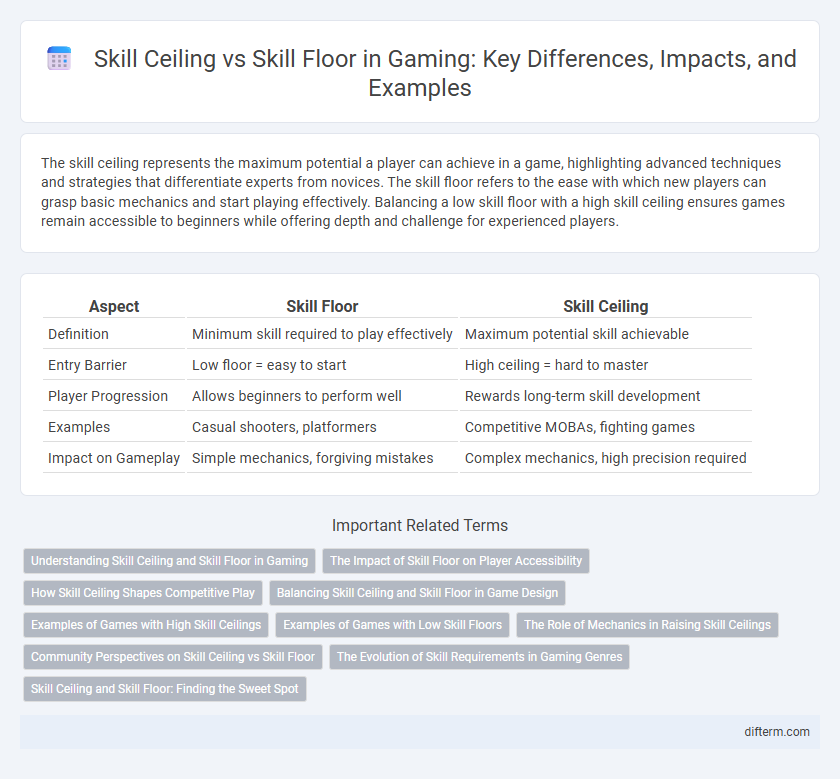The skill ceiling represents the maximum potential a player can achieve in a game, highlighting advanced techniques and strategies that differentiate experts from novices. The skill floor refers to the ease with which new players can grasp basic mechanics and start playing effectively. Balancing a low skill floor with a high skill ceiling ensures games remain accessible to beginners while offering depth and challenge for experienced players.
Table of Comparison
| Aspect | Skill Floor | Skill Ceiling |
|---|---|---|
| Definition | Minimum skill required to play effectively | Maximum potential skill achievable |
| Entry Barrier | Low floor = easy to start | High ceiling = hard to master |
| Player Progression | Allows beginners to perform well | Rewards long-term skill development |
| Examples | Casual shooters, platformers | Competitive MOBAs, fighting games |
| Impact on Gameplay | Simple mechanics, forgiving mistakes | Complex mechanics, high precision required |
Understanding Skill Ceiling and Skill Floor in Gaming
Skill ceiling refers to the maximum potential a player can achieve in a game, representing the highest level of mastery and complexity available. Skill floor indicates the minimum ability required to play effectively, ensuring accessibility for beginners and casual players. Understanding both skill ceiling and skill floor helps developers balance games to attract a diverse player base while providing depth for competitive play.
The Impact of Skill Floor on Player Accessibility
A low skill floor in gaming significantly enhances player accessibility by allowing beginners to quickly grasp basic mechanics and enjoy the game without steep learning curves. Games designed with approachable controls and intuitive objectives help retain a broader audience, fostering community growth. This increased accessibility lowers barriers to entry, encouraging diverse player participation and long-term engagement.
How Skill Ceiling Shapes Competitive Play
The skill ceiling in gaming defines the maximum potential mastery achievable by players, influencing the depth and complexity of competitive play. Higher skill ceilings encourage innovation, strategic diversity, and long-term engagement among elite players, fostering a dynamic meta. Games with well-defined skill ceilings often see tournaments and esports scenes thrive, as top-level gameplay consistently evolves and pushes the boundaries of player capability.
Balancing Skill Ceiling and Skill Floor in Game Design
Balancing skill ceiling and skill floor is crucial in game design to ensure accessibility for newcomers while providing depth for veterans. Lowering the skill floor through intuitive controls and clear mechanics invites new players, whereas a high skill ceiling encourages mastery and long-term engagement. Effective balancing creates a rewarding experience that caters to diverse player skills and sustains competitive fairness.
Examples of Games with High Skill Ceilings
Games such as "Dota 2," "StarCraft II," and "Quake III Arena" exemplify high skill ceilings, demanding precise mechanics, strategic depth, and continuous skill refinement. These titles challenge players with complex controls and diverse meta-games, rewarding mastery and tactical decision-making. High skill ceilings in these games foster competitive environments where player progression is marked by significant improvement and strategic innovation.
Examples of Games with Low Skill Floors
Games with low skill floors such as Fortnite and Among Us allow new players to quickly grasp basic mechanics and enjoy gameplay without steep learning curves. These titles feature intuitive controls and straightforward objectives, lowering barriers for entry and fostering casual player engagement. Easy accessibility in these games promotes broader audience appeal and rapid community growth.
The Role of Mechanics in Raising Skill Ceilings
The role of mechanics in raising skill ceilings is pivotal in competitive gaming, as intricate input precision and advanced techniques broaden the range of player mastery. Complex mechanics such as precise timing, multi-finger coordination, and adaptive strategies increase the skill ceiling by rewarding players who invest time in refining their execution. Game designers leverage high mechanical depth to create challenging environments where expert proficiency distinguishes top-tier players from novices.
Community Perspectives on Skill Ceiling vs Skill Floor
Community perspectives on skill ceiling versus skill floor often highlight how different player bases value accessibility and mastery depth in gaming. Competitive players tend to emphasize a high skill ceiling to ensure long-term engagement and complexity, while casual gamers prioritize a low skill floor for approachability and quick enjoyment. Balancing these elements impacts player retention, game longevity, and overall community satisfaction within the gaming ecosystem.
The Evolution of Skill Requirements in Gaming Genres
The evolution of skill requirements in gaming genres highlights the widening gap between skill floor and skill ceiling, where modern competitive games now demand both accessible entry points and complex mastery layers. Genres like MOBAs and fighting games feature low skill floors to attract new players while maintaining high skill ceilings that challenge veterans with advanced mechanics and strategic depth. This dynamic promotes longevity and continuous player engagement as gamers evolve from basic execution to expert-level decision-making and precision.
Skill Ceiling and Skill Floor: Finding the Sweet Spot
In gaming, the skill ceiling represents the maximum potential mastery and complexity a game offers, while the skill floor defines the minimum competence needed to play effectively. Striking the right balance between these two creates a sweet spot where the game remains accessible for beginners yet challenging enough for experts to continually improve. This equilibrium helps maintain player engagement, fostering a diverse community and extending a game's longevity in competitive scenes.
skill ceiling vs skill floor Infographic

 difterm.com
difterm.com